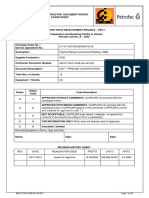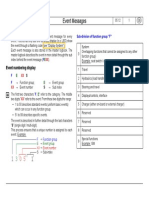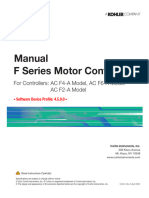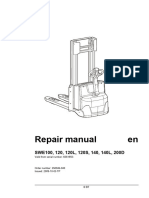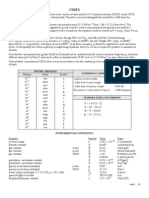UK - CURTIS - 1243 Diagnostic
UK - CURTIS - 1243 Diagnostic
Uploaded by
TCM BYCopyright:
Available Formats
UK - CURTIS - 1243 Diagnostic
UK - CURTIS - 1243 Diagnostic
Uploaded by
TCM BYOriginal Title
Copyright
Available Formats
Share this document
Did you find this document useful?
Is this content inappropriate?
Copyright:
Available Formats
UK - CURTIS - 1243 Diagnostic
UK - CURTIS - 1243 Diagnostic
Uploaded by
TCM BYCopyright:
Available Formats
7 — DIAGNOSTICS & TROUBLESHOOTING
7 DIAGNOSTICS AND TROUBLESHOOTING
The 1243GEN2 controller provides diagnostics information to assist technicians
in troubleshooting drive system problems. The diagnostics information can be
obtained by observing the appropriate display on the programming device, the
fault message displayed on the Spyglass gauge, the fault codes issued by the Status
LED, or the fault display driven by the controller’s fault outputs (Fault 1 and
Fault 2). Refer to the troubleshooting chart (Table 7) for suggestions covering
a wide range of possible faults.
PROGRAMMER DIAGNOSTICS
The programming device presents complete diagnostic information in plain
language. Faults are displayed in the Faults/Diagnostics Menu, and the status
of the controller inputs/outputs is displayed in the Monitor Menu.
Accessing the programmer’s fault history file provides a list of the faults
that have occurred since the history file was last cleared. Checking (and clear-
ing) the history file is recommended each time the vehicle is brought in for
maintenance.
SPYGLASS DIAGNOSTICS
The eight-character LCD on the Spyglass displays a continuous sequence of
hourmeter, battery state-of-charge, and fault messages.
Fault messages are displayed using the same codes that are flashed by
the LED (see Table 8). For example, the LED flashes 3,2 for a welded main
contactor:
¤¤¤ ¤¤ ¤¤¤ ¤¤ ¤¤¤ ¤¤
(3,2) (3,2) (3,2)
and the corresponding Spyglass message is:
CODE 32
When a fault message is being displayed, the red Fault LED (labeled with
a wrench symbol) flashes to catch the operator’s attention.
The LCD also displays a warning when either service timer expires. The
service warning is not considered a fault and the red Fault LED does not flash.
The word SERVICE is displayed for about 20 seconds on each key-on, after
the hourmeter is displayed.
The Spyglass is available in 3-LED and 6-LED models; see Figure 21.
Curtis 1243GEN2 Manual, Rev. B 71
7 — DIAGNOSTICS & TROUBLESHOOTING
Table 7 TROUBLESHOOTING CHART
LED PROGRAMMER FAULT
CODE LCD DISPLAY CATEGORY POSSIBLE CAUSE FAULT CLEARANCE
0,1 NO KNOWN FAULTS 0 n/a n/a
1,1 CURRENT SHUNT FAULT 1 1. Abnormal vehicle operation causing Cycle KSI. If problem
high current spikes. persists, replace controller.
2. Current sensor out of range.
3. Controller failure.
1,2 HW FAILSAFE 1 1. Noisy environment. Cycle KSI. If problem
2. Self-test or watchdog fault. persists, replace controller.
3. Controller failure.
1,3 M- SHORTED 1 1. Internal or external short of M- to B-. Check wiring; cycle KSI.
2. Incorrect motor wiring. If problem persists,
3. Controller failure. replace controller.
1,4 SRO 3 1. Improper sequence of KSI, interlock, Follow proper sequence;
and direction inputs. adjust throttle if necessary;
2. Interlock or direction switch circuit open. adjust programmable
3. Sequencing delay too short. parameters if necessary.
4. Wrong SRO or throttle type selected.
5. Misadjusted throttle pot.
2,1 THROTTLE WIPER HI 1 1. Throttle input wire open or shorted to B+. When Throttle Wiper High
2. Defective throttle pot. input returns to valid range.
3. Wrong throttle type selected.
2,2 EMR REV WIRING 1 1. Emergency reverse wire or check wire Re-apply emergency reverse
open. or cycle interlock.
2,3 HPD 3 1. Improper sequence of KSI, interlock, Follow proper sequence;
and throttle inputs. adjust throttle if necessary;
2. Misadjusted throttle pot. adjust programmable
3. Sequencing delay too short. parameters if necessary.
3. Wrong HPD or throttle type selected.
5. Misadjusted throttle pot.
SRVC TOTAL 3 1. Total maintenance timer expired. Reset with programmer.
SRVC TRAC 3 1. Traction maintenance timer expired. Reset with programmer.
TOTAL DISABLED 3 1. Total disable timer expired. Reset with programmer.
TRAC DISABLED 3 1. Traction disable timer expired. Reset with programmer.
2,4 THROTTLE WIPER LO 1 1. Throttle pot wire open or shorted to B+. When Throttle Wiper Low
2. Wrong throttle type selected. input returns to valid range.
3. Defective throttle pot.
3,1 FIELD SHORT 1 1. Main contactor coil shorted. Check contactor coil and
2. Field winding shorted to B+ or B-. field winding; cycle KSI.
3. Field resistance too low.
3,2 MAIN CONT WELDED 1 1. Main contactor stuck closed. Check wiring and contactor;
2. Main contactor driver shorted. cycle KSI.
3,3 FIELD OPEN 1 1. Field winding connection open. Check wiring and cycle KSI.
2. Field winding open.
3,4 MISSING CONTACTOR 1 1. Main contactor coil open. Check wiring and cycle KSI.
2. Main contactor missing.
3. Wire to main contactor open.
72 Curtis 1243GEN2 Manual, Rev. B
7 — DIAGNOSTICS & TROUBLESHOOTING
Table 7 TROUBLESHOOTING CHART, cont’d
LED PROGRAMMER FAULT
CODE LCD DISPLAY CATEGORY POSSIBLE CAUSE FAULT CLEARANCE
4,1 LOW BATTERY VOLTAGE 2 1. Battery voltage < undervoltage cutback. When voltage rises above
2. Corroded battery terminal. undervoltage cutoff point.
3. Loose battery or controller terminal.
4,2 OVERVOLTAGE 2 1. Battery voltage >overvoltage shutdown. When voltage falls below
limit. overvoltage cutoff point.
2. Vehicle operating with charger attached.
4,3 THERMAL CUTBACK 2 1. Temperature >85°C or < -25°C. Clears when heatsink
2. Excessive load on vehicle. temperature returns to
3. Improper mounting of controller. within acceptable range.
4,4 ANTI-TIEDOWN 3 1. Mode switches shorted to B+. Release Mode Select 1.
2. Mode Select 1 “tied down” to select
Mode 2 or Mode 4 permanently.
MOTOR HOT 3 1. Field resistance > motor hot setpoint. When resistance < setpoint.
MOTOR WARM 3 1. Field resistance > motor warm setpoint. When resistance < setpoint.
Fig. 21 Curtis 840
Spyglass, 3-LED 3-LED Spyglass The hourmeter LED lights when the LCD
is displaying hourmeter data.
and 6-LED models.
The BDI LED lights when the LCD is dis-
playing BDI%. It flashes when BDI% drops
to <10%.
The Fault LED flashes to indicate an ac-
tive fault, and the fault code appears on
the LCD.
8-character LCD display
The word SERVICE is displayed at key-on
if either service timer has expired.
Hourmeter LED (green) Fault LED (red)
BDI LED (yellow)
6-LED Spyglass
The three green BDI LEDs function as a
bargraph showing BDI% between 52% and
100%.
Yellow LED = 36% – 51% BDI. Fault LED (red)
Red LED steady = 20% – 35% BDI.
Red LED flashing = 0 – 19% BDI. 8-character LCD display
The Fault LED flashes to indicate an ac-
tive fault, and the fault code appears on 0 1
red
the LCD.
yellow green
The word SERVICE is displayed at key-on
if either service timer has expired. BDI 0–100% LEDs
Curtis 1243GEN2 Manual, Rev. B 73
7 — DIAGNOSTICS & TROUBLESHOOTING
STATUS LED DIAGNOSTICS
A Status LED is built into the 1243GEN2 controller. It is visible through a win-
dow in the label on top of the controller. This Status LED displays fault codes
when there is a problem with the controller or with the inputs to the controller.
During normal operation, with no faults present, the Status LED flashes steadily
on and off. If the controller detects a fault, a 2-digit fault identification code is
flashed continuously until the fault is corrected. For example, code “3,2”—main
contactor welded—appears as:
¤¤¤ ¤¤ ¤¤¤ ¤¤ ¤¤¤ ¤¤
(3,2) (3,2) (3,2)
The codes are listed in Table 8.
Table 8 STATUS LED FAULT CODES
LED CODES EXPLANATION
LED off no power or defective controller
solid on controller or microprocessor fault
0,1 ■ ¤ controller operational; no faults
1,1 ¤ ¤ current sensor error
1,2 ¤ ¤¤ hardware failsafe fault
1,3 ¤ ¤¤¤ M- fault or motor output short
1,4 ¤ ¤¤¤¤ static return to off (SRO)
2,1 ¤¤ ¤ throttle wiper high
2,2 ¤¤ ¤¤ emergency reverse circuit check fault
2,3 ¤¤ ¤¤¤ high pedal disable (HPD), or expired timer
2,4 ¤¤ ¤¤¤¤ throttle wiper low
3,1 ¤¤¤ ¤ contactor driver overcurrent or field winding short
3,2 ¤¤¤ ¤¤ main contactor welded
3,3 ¤¤¤ ¤¤¤ field winding open
3,4 ¤¤¤ ¤¤¤¤ missing contactor
4,1 ¤¤¤¤ ¤ low battery voltage
4,2 ¤¤¤¤ ¤¤ overvoltage
4,3 ¤¤¤¤ ¤¤¤ thermal cutback, due to over/under temp
4,4 ¤¤¤¤ ¤¤¤¤ anti-tiedown fault, or overheated motor
Note: Only one fault is indicated at a time, and faults are not queued up. Refer
to the troubleshooting chart (Table 7) for suggestions about possible causes of
the various faults. Operational faults—such as a fault in SRO sequencing—are
cleared by cycling the interlock switch or keyswitch.
74 Curtis 1243GEN2 Manual, Rev. B
You might also like
- BT CodeDocument56 pagesBT CodeFiras Maitig67% (3)
- PEB Checklist GL 1-2-20.9.16Document4 pagesPEB Checklist GL 1-2-20.9.16Prem Kumar90% (10)
- Flexi-ACiON-User-Manual Manual de CodigosDocument89 pagesFlexi-ACiON-User-Manual Manual de CodigosfranciscoNo ratings yet
- Crosman Service Manual 1960s BookDocument167 pagesCrosman Service Manual 1960s BookJust4Him60% (20)
- Crown RC3000Document6 pagesCrown RC3000Saul Rosales100% (1)
- Yale AC CONTROLLERDocument118 pagesYale AC CONTROLLERCarlos100% (10)
- Mitsubishi Error Codes List Forklift ElectricDocument2 pagesMitsubishi Error Codes List Forklift ElectricPetr80% (10)
- Truckcom TE ManualDocument44 pagesTruckcom TE ManualNgo Ngoc Tu100% (9)
- Zapi Dual Ace2Document169 pagesZapi Dual Ace2Андрей9100% (2)
- en (Ere 120)Document207 pagesen (Ere 120)Nadeem Ahmed100% (2)
- BT Optio H-Series - TMHIDocument141 pagesBT Optio H-Series - TMHIPatricio Castro100% (1)
- BT Forklift C3E150 C3E200 C4E150 C4E200 Repair Manual 036 0437 00 (251 400)Document150 pagesBT Forklift C3E150 C3E200 C4E150 C4E200 Repair Manual 036 0437 00 (251 400)vladimirNo ratings yet
- TROUBLESHOOTING - EVENT CODES sc4000Document101 pagesTROUBLESHOOTING - EVENT CODES sc4000onesimo100% (1)
- Life Speed Service ManualDocument13 pagesLife Speed Service ManualCxar RodNo ratings yet
- Ac Bendi Fault CodesDocument10 pagesAc Bendi Fault CodesChristian Bedoya75% (4)
- Atf Fault Codes PDFDocument120 pagesAtf Fault Codes PDFFatih YÜKSEL100% (3)
- Manual de Diagnostico S 1.6Document28 pagesManual de Diagnostico S 1.6Kaique Mello100% (1)
- EFG VAC FehlerDocument41 pagesEFG VAC FehlerDariusz Bartniak100% (5)
- ZAPI AC-0 ManualDocument62 pagesZAPI AC-0 ManualRizki Febri80% (5)
- Qcp-Pipeline ConstructionDocument20 pagesQcp-Pipeline Constructionbelhaska100% (2)
- Diagnostico YALE MR16 (c849)Document11 pagesDiagnostico YALE MR16 (c849)Paulo Henrique75% (4)
- Curtus Controller Manual 1236 1238Document13 pagesCurtus Controller Manual 1236 1238Eriflona100% (1)
- Systemmeldungen GBDocument28 pagesSystemmeldungen GBAhmet0% (1)
- AC Superdrive (ACS) : DescriptionDocument2 pagesAC Superdrive (ACS) : DescriptionMamadou djibril Ba100% (1)
- Yale MPB040E MPW045EDocument13 pagesYale MPB040E MPW045EEdinson Floriano0% (1)
- ZAPI AC-1 ManualDocument62 pagesZAPI AC-1 ManualMarcos Gregorio da SilvaNo ratings yet
- Controls For Electric & Gas Forklifts, Golf CartsDocument124 pagesControls For Electric & Gas Forklifts, Golf CartsFaizal Jamal60% (10)
- Aelzp0be (SMART-DISPLAY-ing) PDFDocument46 pagesAelzp0be (SMART-DISPLAY-ing) PDFalberto100% (4)
- Jungheinrich Ejc112 & E1202Document184 pagesJungheinrich Ejc112 & E1202Thomas Hansen80% (10)
- Portable Electrical Equipment Prompt SheetDocument2 pagesPortable Electrical Equipment Prompt Sheetmyo zaw100% (1)
- Ayush 100 Recipes EnglishDocument53 pagesAyush 100 Recipes EnglishLaura Villalobos100% (1)
- Zapi Ac0 Manual 092004 enDocument75 pagesZapi Ac0 Manual 092004 enbanejusty100% (2)
- Zapi FZ5017 & 5018 CodesDocument3 pagesZapi FZ5017 & 5018 CodesSaid Reda100% (1)
- Yale MPB 040 EDocument13 pagesYale MPB 040 EJMautoelevadores El servicio que estabas esperandoNo ratings yet
- Repair Manual 258944-040: LWE140, LWE160, LWE180, LWE200, LWE250Document230 pagesRepair Manual 258944-040: LWE140, LWE160, LWE180, LWE200, LWE250valter132.vsNo ratings yet
- Cat E5000 07Document44 pagesCat E5000 07Kevin DaughtonNo ratings yet
- RPL201H Traction Controller Error Code ListDocument19 pagesRPL201H Traction Controller Error Code Listvictor lara100% (1)
- SM Swe120l, 160D 229101-040Document168 pagesSM Swe120l, 160D 229101-040К ШNo ratings yet
- Aemzp0ba (EPS AC0 Ing)Document95 pagesAemzp0ba (EPS AC0 Ing)Ricardo Gamez Ortega100% (1)
- 1234 - 36 - 38 Manual Rev Feb 09 PDFDocument134 pages1234 - 36 - 38 Manual Rev Feb 09 PDFPedro NetoNo ratings yet
- PBM Power PointDocument32 pagesPBM Power PointCarlos Quispe100% (1)
- Ace2 Inverter: User ManualDocument85 pagesAce2 Inverter: User ManualAdam Schwemlein100% (2)
- Cbe 12-20T&FDocument108 pagesCbe 12-20T&FSARAMQR60% (5)
- Codigos Fallas SP 3000Document47 pagesCodigos Fallas SP 3000Luis Castro BasualtoNo ratings yet
- ZAPI AC-0 Manual Carretillas EPDocument62 pagesZAPI AC-0 Manual Carretillas EPRicardo Gamez Ortega50% (2)
- Manual Reparacao ME4 547957ENDocument172 pagesManual Reparacao ME4 547957ENPaulo SousaNo ratings yet
- Curtis F SeriesDocument277 pagesCurtis F SeriesJuan Carlos Rubio Fresco100% (1)
- Technical Information For YALE Service CentresDocument292 pagesTechnical Information For YALE Service Centresclaiton100% (1)
- MOTOR Caterpillar Forklift E3500-E5000Document26 pagesMOTOR Caterpillar Forklift E3500-E5000Nabot tecnicosNo ratings yet
- Curtis 1232 Se Spec SheetDocument9 pagesCurtis 1232 Se Spec SheetRandalNo ratings yet
- EV100-200LX Controller and Handset TroubleshootingDocument70 pagesEV100-200LX Controller and Handset TroubleshootingTan Jai100% (2)
- Mpe060 B896-1Document118 pagesMpe060 B896-1vanderjuniorvandinhocb02367% (3)
- Codigo de Falha E45-70xnDocument7 pagesCodigo de Falha E45-70xnSuziane Sousa Victor100% (1)
- 1207A & 1207 ManualDocument70 pages1207A & 1207 ManualNILTON MOR100% (1)
- Diagrama Erc VGDocument36 pagesDiagrama Erc VGCarlos83% (6)
- TOYOTA BT SWE140S Powered Stacker Forklift Service Repair Manual PDFDocument24 pagesTOYOTA BT SWE140S Powered Stacker Forklift Service Repair Manual PDFfkdmma100% (2)
- RM Swe120lDocument210 pagesRM Swe120lmarchelaNo ratings yet
- 227761-040 Vce150aDocument262 pages227761-040 Vce150aWagner BernardinaNo ratings yet
- Electrical Diagrams: Ac Motor Control SystemDocument80 pagesElectrical Diagrams: Ac Motor Control SystemJohn fredy cuervo100% (1)
- Jungheinrich EJC Z14 Z16 Operating Instruction 50470245 06.2005 deDocument87 pagesJungheinrich EJC Z14 Z16 Operating Instruction 50470245 06.2005 deKobelco RepairNo ratings yet
- KUBOTA U35-3 Panel Self Test ToolDocument5 pagesKUBOTA U35-3 Panel Self Test ToolCatalinNo ratings yet
- MC 31Document33 pagesMC 31nick321walkerNo ratings yet
- Um Gos-6100 82os Gos-6103cm0 eDocument30 pagesUm Gos-6100 82os Gos-6103cm0 esanjuanramirezurielabisaiNo ratings yet
- 2engine SystemDocument74 pages2engine Systemmarcelopalacio068No ratings yet
- Electric Forklift Truck: Operation & Maintenance ManualDocument148 pagesElectric Forklift Truck: Operation & Maintenance ManualTCM BY100% (1)
- БВ 2733 Чертежи Быстроизнашивающихся ДеталейDocument15 pagesБВ 2733 Чертежи Быстроизнашивающихся ДеталейTCM BYNo ratings yet
- PartsDocument203 pagesPartsTCM BYNo ratings yet
- FD30-16 S/N 700001-UP: Steel Cabin Inner Parts (Front Wiper) (#712345-)Document1 pageFD30-16 S/N 700001-UP: Steel Cabin Inner Parts (Front Wiper) (#712345-)TCM BYNo ratings yet
- FD30-16 S/N 700001-UP: Steel Cabin Inner Parts (Front Glass and Rear GLASS) (#712345-)Document1 pageFD30-16 S/N 700001-UP: Steel Cabin Inner Parts (Front Glass and Rear GLASS) (#712345-)TCM BYNo ratings yet
- BSC Summit Historical Trends in VS - CLVillanoyDocument14 pagesBSC Summit Historical Trends in VS - CLVillanoygerald hullezaNo ratings yet
- 2 Units Conversion FactorsDocument2 pages2 Units Conversion FactorsRalph Saint PierreNo ratings yet
- One of The Most Powerful Chest Exercises For Men PDFDocument26 pagesOne of The Most Powerful Chest Exercises For Men PDFCartouche100% (2)
- Abhijeet Techno Plast India PVT Ltd. Standard Operating ProcedureDocument8 pagesAbhijeet Techno Plast India PVT Ltd. Standard Operating Procedureshobha shelarNo ratings yet
- 1 Identification of The Substance/mixture and of The Company/undertakingDocument6 pages1 Identification of The Substance/mixture and of The Company/undertakingPepitoNo ratings yet
- Influence of Feed Water Heaters On The Performance of Coal Fired Power PlantsDocument5 pagesInfluence of Feed Water Heaters On The Performance of Coal Fired Power Plantsmohammed kareemNo ratings yet
- Ug136 Ble C Soc Dev GuideDocument35 pagesUg136 Ble C Soc Dev GuideVenkat KrishnanNo ratings yet
- Public Trust DoctrineDocument27 pagesPublic Trust DoctrineSayan GhoshNo ratings yet
- Preventa XY2C - XY2CE1A250Document5 pagesPreventa XY2C - XY2CE1A250pardocarr4091No ratings yet
- NSRP 0528 Reduction & Elimination of Welded Temporary AttachmentsDocument112 pagesNSRP 0528 Reduction & Elimination of Welded Temporary AttachmentsRobert DelafosseNo ratings yet
- Chemistry Journal Chjv06i06p0596Document18 pagesChemistry Journal Chjv06i06p0596Meysam BayazidiNo ratings yet
- RDO No. 35 - Odiongan, RomblonDocument399 pagesRDO No. 35 - Odiongan, RomblongerwinocsenaNo ratings yet
- Genbio2 q2 Mod1.1 Reproduction-And-DevelopmentDocument9 pagesGenbio2 q2 Mod1.1 Reproduction-And-DevelopmentHazel AbitriaNo ratings yet
- Differential Equation PDFDocument3 pagesDifferential Equation PDFhasanNo ratings yet
- P 131Document7 pagesP 131Marciel AmorimNo ratings yet
- BSS Katalog 2021Document340 pagesBSS Katalog 2021D ŠpokauskasNo ratings yet
- Big Gear Inspection Is Booming: Oil Additives Can International CalculationDocument68 pagesBig Gear Inspection Is Booming: Oil Additives Can International CalculationmapalptsNo ratings yet
- Dark Sun - New WeaponsDocument5 pagesDark Sun - New WeaponsDylan Flippance100% (5)
- FLUID DYNAMICS AutosavedDocument35 pagesFLUID DYNAMICS AutosavedCrisamor De VillaNo ratings yet
- Using Colloidal Silver To Eliminate Moles On The SkinDocument5 pagesUsing Colloidal Silver To Eliminate Moles On The SkinduhitijeloNo ratings yet
- Custom Trays: Individualized Trays For Making Final Impressions Made On A Diagnostic CastDocument25 pagesCustom Trays: Individualized Trays For Making Final Impressions Made On A Diagnostic Castparee1No ratings yet
- Scotsman MF 86 Service ManualDocument30 pagesScotsman MF 86 Service ManualMARILHITT PIAMONTENo ratings yet
- Orion Astroview Equatorial Mount: Instruction ManualDocument10 pagesOrion Astroview Equatorial Mount: Instruction ManualfhherelujjdhuiorrNo ratings yet
- AAS. Sweetser, T. The Eccentric Behavior of Nearly Frozen Orbits (Lunar) (LFO)Document13 pagesAAS. Sweetser, T. The Eccentric Behavior of Nearly Frozen Orbits (Lunar) (LFO)darin koblickNo ratings yet
- Brochure BIMOX 2023Document4 pagesBrochure BIMOX 2023Anis KhanNo ratings yet



















